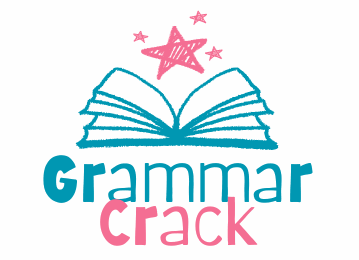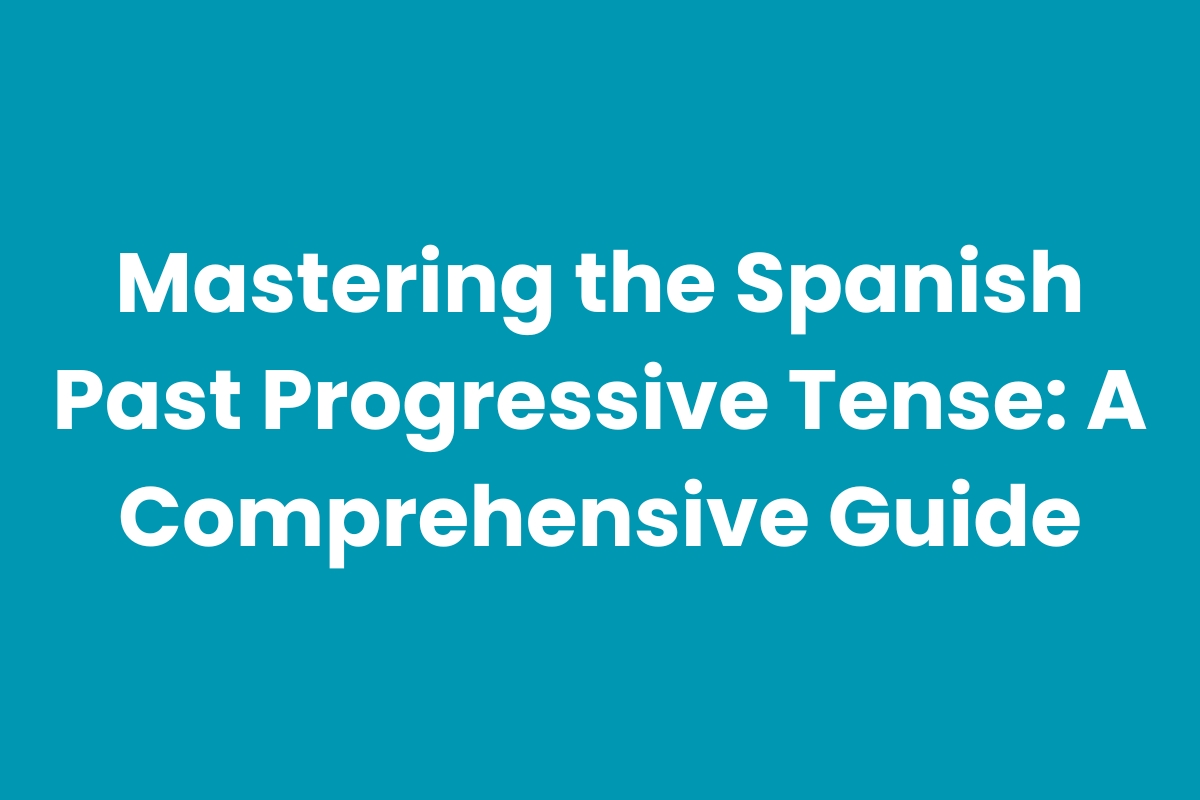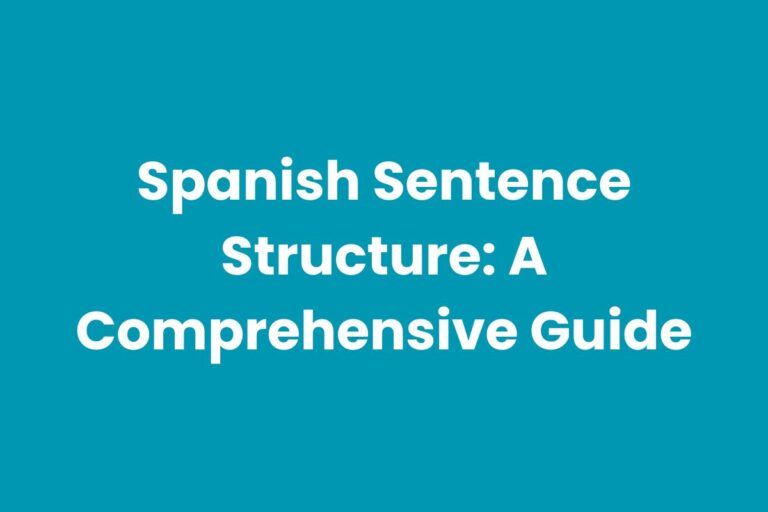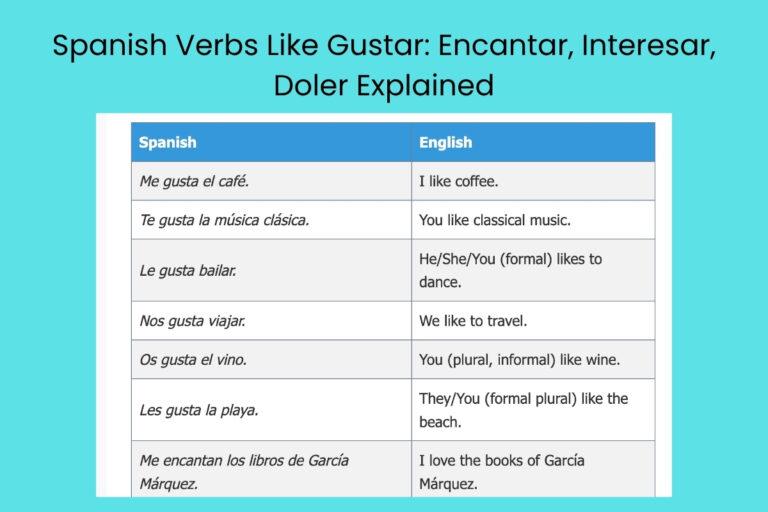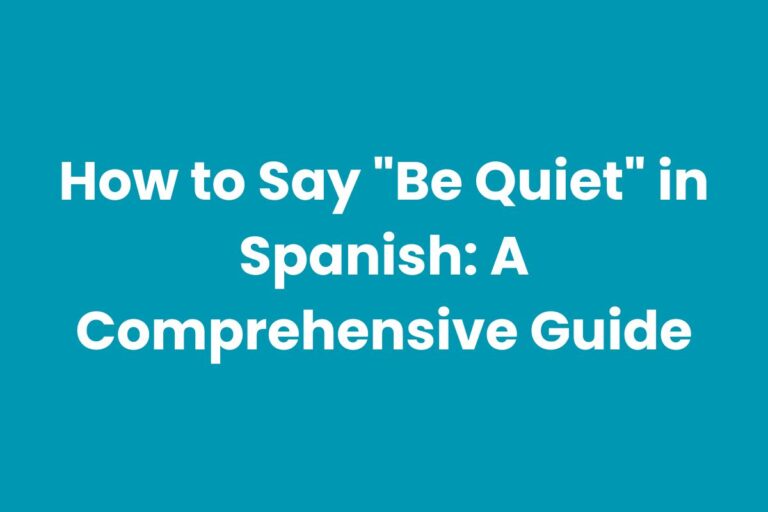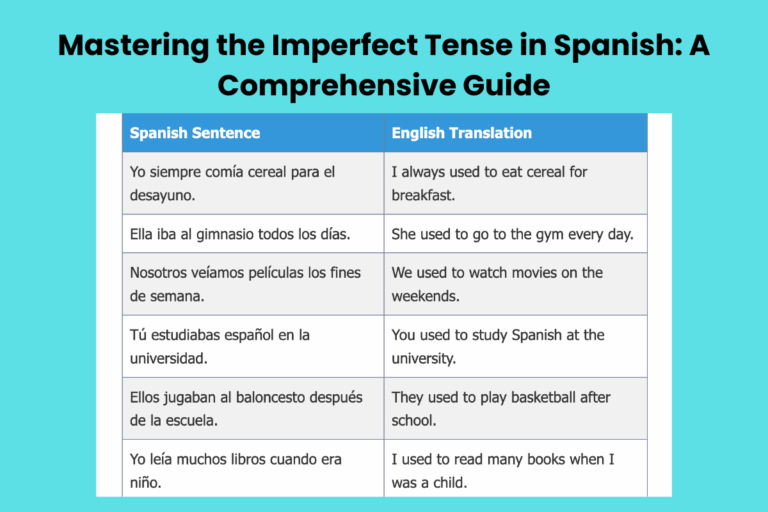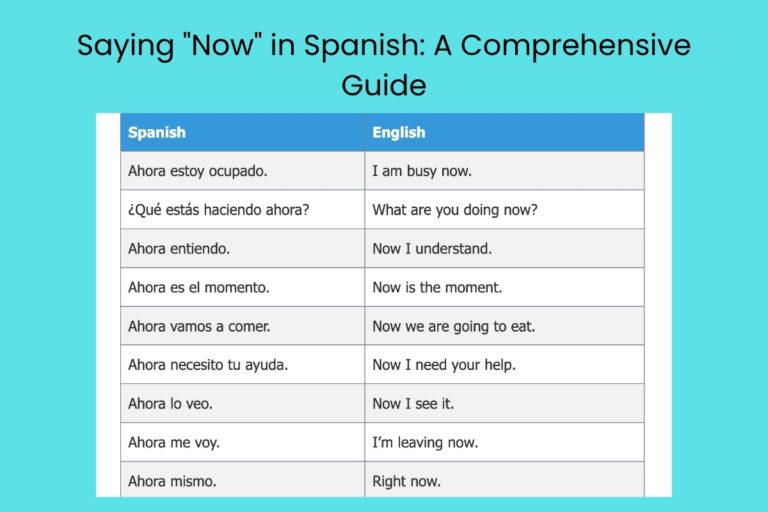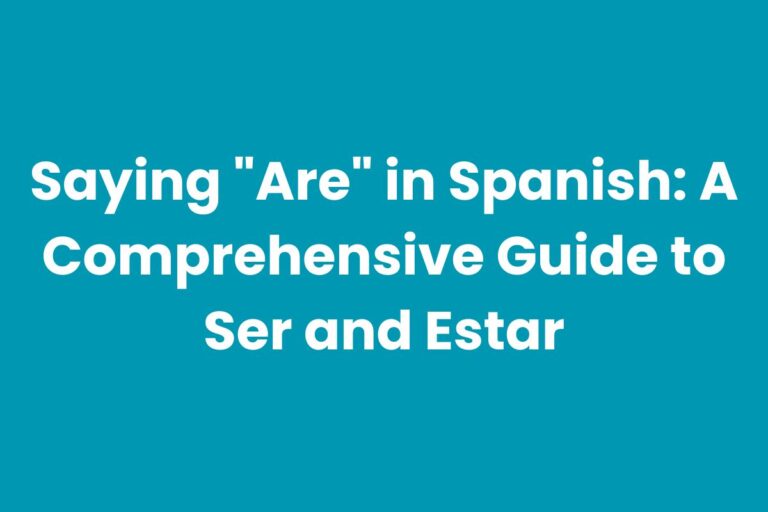Mastering the Spanish Past Progressive Tense: A Comprehensive Guide
The Spanish Past Progressive, or Imperfect Progressive, is a crucial aspect of Spanish grammar, allowing you to describe actions that were in progress at a specific point in the past. Understanding this tense enables you to paint vivid pictures of past events, adding depth and nuance to your storytelling.
This guide is designed for students of all levels, from beginners seeking a solid foundation to advanced learners aiming to refine their proficiency. By mastering the Spanish Past Progressive, you’ll significantly enhance your ability to communicate effectively and express yourself with greater precision.
Table of Contents
- Definition of the Spanish Past Progressive
- Structural Breakdown
- Types and Categories
- Examples of the Past Progressive
- Usage Rules
- Common Mistakes
- Practice Exercises
- Advanced Topics
- Frequently Asked Questions (FAQ)
- Conclusion
Definition of the Spanish Past Progressive
The Spanish Past Progressive, also known as the Imperfect Progressive (Pretérito Imperfecto Progresivo), is a verb tense used to describe actions that were in progress at a specific time in the past. It conveys the idea that an action was ongoing, continuous, or in the middle of happening. Unlike the simple past tense (pretérito indefinido), which describes completed actions, the past progressive emphasizes the duration and continuity of the action. It is formed by combining the imperfect form of the verb estar (to be) with the gerund (gerundio) of the main verb. This tense is crucial for providing context, painting vivid descriptions, and conveying a sense of immersion in past events. It’s a fundamental tool for narrating stories, describing past routines, and expressing simultaneous actions.
Structural Breakdown
The structure of the Spanish Past Progressive is relatively straightforward. It consists of two main components: the imperfect form of the verb estar and the gerund of the main verb. Understanding how to form each of these components is essential for mastering the tense.
Conjugating Estar
The first step is to conjugate the verb estar (to be) in the imperfect tense. The imperfect tense is used to describe ongoing or habitual actions in the past. Here’s the conjugation of estar in the imperfect tense:
- Yo estaba (I was)
- Tú estabas (You were)
- Él/Ella/Usted estaba (He/She/You (formal) was)
- Nosotros/Nosotras estábamos (We were)
- Vosotros/Vosotras estabais (You (plural, informal) were)
- Ellos/Ellas/Ustedes estaban (They/You (plural, formal) were)
Memorizing this conjugation is crucial because it forms the foundation of the past progressive tense. Without a solid understanding of the imperfect form of estar, you won’t be able to construct the tense correctly.
Forming the Gerund
The second step is to form the gerund of the main verb. The gerund is the ‘-ing’ form of the verb in English.
In Spanish, the gerund is formed by adding ‘-ando’ to the stem of -ar verbs and ‘-iendo’ to the stem of -er and -ir verbs. Here are some examples:
- Hablar (to speak) -> Hablando (speaking)
- Comer (to eat) -> Comiendo (eating)
- Vivir (to live) -> Viviendo (living)
There are some irregular gerunds, particularly for verbs with stem changes. For example, verbs like dormir (to sleep) and pedir (to ask for) have stem changes in the gerund:
- Dormir (to sleep) -> Durmiendo (sleeping)
- Pedir (to ask for) -> Pidiendo (asking)
Verbs ending in vowel + -er or vowel + -ir require a slight modification in the gerund form, changing ‘-iendo’ to ‘-yendo’:
- Leer (to read) -> Leyendo (reading)
- Oír (to hear) -> Oyendo (hearing)
Once you have the imperfect form of estar and the gerund of the main verb, you can combine them to form the past progressive tense. For example:
Yo estaba hablando (I was speaking)
Ella estaba comiendo (She was eating)
Nosotros estábamos viviendo (We were living)
Types and Categories
While the basic structure of the past progressive remains consistent, the types of verbs used can influence the nuance of the sentence. We can categorize the use of the past progressive based on the type of verb employed, such as regular verbs, irregular verbs, and reflexive verbs.
Examples of the Past Progressive
To solidify your understanding of the Spanish Past Progressive, let’s look at a variety of examples using different types of verbs. These examples will illustrate how the tense is used in context and how to form it correctly.
Regular Verbs
Regular verbs follow the standard rules for forming the gerund. The following table showcases the use of past progressive with regular verbs.
| Subject | Sentence | Translation |
|---|---|---|
| Yo | Yo estaba cantando en la ducha. | I was singing in the shower. |
| Tú | Tú estabas bailando en la fiesta. | You were dancing at the party. |
| Él | Él estaba trabajando hasta tarde. | He was working late. |
| Ella | Ella estaba cocinando la cena. | She was cooking dinner. |
| Usted | Usted estaba caminando en el parque. | You were walking in the park. |
| Nosotros | Nosotros estábamos estudiando para el examen. | We were studying for the exam. |
| Vosotros | Vosotros estabais jugando al fútbol. | You were playing soccer. |
| Ellos | Ellos estaban mirando la televisión. | They were watching television. |
| Ellas | Ellas estaban hablando por teléfono. | They were talking on the phone. |
| Ustedes | Ustedes estaban esperando el autobús. | You were waiting for the bus. |
| Yo | Yo estaba dibujando un paisaje. | I was drawing a landscape. |
| Tú | Tú estabas escuchando música. | You were listening to music. |
| Él | Él estaba nadando en la piscina. | He was swimming in the pool. |
| Ella | Ella estaba leyendo un libro. | She was reading a book. |
| Usted | Usted estaba viajando por Europa. | You were traveling through Europe. |
| Nosotros | Nosotros estábamos limpiando la casa. | We were cleaning the house. |
| Vosotros | Vosotros estabais escribiendo un correo electrónico. | You were writing an email. |
| Ellos | Ellos estaban aprendiendo español. | They were learning Spanish. |
| Ellas | Ellas estaban visitando a sus abuelos. | They were visiting their grandparents. |
| Ustedes | Ustedes estaban comiendo en el restaurante. | You were eating at the restaurant. |
| Yo | Yo estaba pensando en ti. | I was thinking about you. |
| Tú | Tú estabas caminando muy rápido. | You were walking very fast. |
| Él | Él estaba buscando las llaves. | He was looking for the keys. |
Irregular Verbs
Irregular verbs have stem changes or other modifications in their gerund form. Common irregular verbs in the gerund include dormir (durmiendo), pedir (pidiendo), leer (leyendo), and oír (oyendo). The following table showcases the use of past progressive with irregular verbs.
| Subject | Sentence | Translation |
|---|---|---|
| Yo | Yo estaba durmiendo cuando sonó el teléfono. | I was sleeping when the phone rang. |
| Tú | Tú estabas pidiendo ayuda. | You were asking for help. |
| Él | Él estaba leyendo el periódico. | He was reading the newspaper. |
| Ella | Ella estaba oyendo música clásica. | She was listening to classical music. |
| Nosotros | Nosotros estábamos construyendo una casa. | We were building a house. |
| Vosotros | Vosotros estabais mintiendo. | You were lying. |
| Ellos | Ellos estaban viniendo a la fiesta. | They were coming to the party. |
| Yo | Yo estaba diciendo la verdad. | I was telling the truth. |
| Tú | Tú estabas trayendo la comida. | You were bringing the food. |
| Él | Él estaba huyendo de la policía. | He was fleeing from the police. |
| Ella | Ella estaba influyendo en la decisión. | She was influencing the decision. |
| Nosotros | Nosotros estábamos sustituyendo los ingredientes. | We were substituting the ingredients. |
| Vosotros | Vosotros estabais destruyendo el castillo de arena. | You were destroying the sandcastle. |
| Ellos | Ellos estaban contruyendo un nuevo edificio. | They were building a new building. |
| Yo | Yo estaba creyendo en sus palabras. | I was believing in his words. |
| Tú | Tú estabas oyendo las noticias. | You were hearing the news. |
| Él | Él estaba leyendo una novela. | He was reading a novel. |
| Ella | Ella estaba durmiendo plácidamente. | She was sleeping peacefully. |
| Nosotros | Nosotros estábamos pidiendo un deseo. | We were making a wish. |
| Vosotros | Vosotros estabais siguiendo las instrucciones. | You were following the instructions. |
| Ellos | Ellos estaban mintiendo sobre su edad. | They were lying about their age. |
Reflexive Verbs
Reflexive verbs are used when the subject and the object of the verb are the same (e.g., “I wash myself”). When using reflexive verbs in the past progressive, the reflexive pronoun (me, te, se, nos, os, se) is placed before the conjugated form of estar. The following table showcases the use of past progressive with reflexive verbs.
| Subject | Sentence | Translation |
|---|---|---|
| Yo | Yo me estaba lavando las manos. | I was washing my hands. |
| Tú | Tú te estabas vistiendo. | You were getting dressed. |
| Él | Él se estaba afeitando. | He was shaving. |
| Ella | Ella se estaba maquillando. | She was putting on makeup. |
| Nosotros | Nosotros nos estábamos preparando para la fiesta. | We were getting ready for the party. |
| Vosotros | Vosotros os estabais duchando. | You were taking a shower. |
| Ellos | Ellos se estaban acostando. | They were going to bed. |
| Yo | Yo me estaba despertando. | I was waking up. |
| Tú | Tú te estabas preocupando demasiado. | You were worrying too much. |
| Él | Él se estaba quejando del ruido. | He was complaining about the noise. |
| Ella | Ella se estaba riendo de la broma. | She was laughing at the joke. |
| Nosotros | Nosotros nos estábamos divirtiendo mucho. | We were having a lot of fun. |
| Vosotros | Vosotros os estabais equivocando de camino. | You were taking the wrong way. |
| Ellos | Ellos se estaban peleando por el juguete. | They were fighting over the toy. |
| Yo | Yo me estaba secando el pelo. | I was drying my hair. |
| Tú | Tú te estabas mirando en el espejo. | You were looking at yourself in the mirror. |
| Él | Él se estaba escondiendo detrás del árbol. | He was hiding behind the tree. |
| Ella | Ella se estaba sintiendo mejor. | She was feeling better. |
| Nosotros | Nosotros nos estábamos acercando a la meta. | We were getting closer to the goal. |
| Ellos | Ellos se estaban preparando para el examen. | They were preparing for the exam. |
Usage Rules
The Spanish Past Progressive is used in specific contexts to convey particular meanings. Understanding these usage rules is essential for using the tense correctly.
Describing Ongoing Actions
The primary use of the past progressive is to describe actions that were in progress at a specific time in the past. This emphasizes the duration and continuity of the action, rather than its completion.
For example:
Ayer a las siete de la tarde, yo estaba cenando. (Yesterday at seven in the evening, I was having dinner.)
Setting the Scene
The past progressive is often used to set the scene in a narrative, providing background information about what was happening when the main events occurred. For example:
La lluvia estaba cayendo y el viento estaba soplando cuando llegamos. (The rain was falling and the wind was blowing when we arrived.)
Interrupting Actions
The past progressive can be used to describe an action that was in progress when another action interrupted it. The interrupting action is usually expressed in the simple past tense (pretérito indefinido). For example:
Yo estaba estudiando cuando mi amigo me llamó. (I was studying when my friend called me.)
Simultaneous Actions
The past progressive can be used to describe two or more actions that were happening at the same time in the past. For example:
Mientras yo estaba cocinando, mi hermano estaba lavando los platos. (While I was cooking, my brother was washing the dishes.)
Common Mistakes
One common mistake is confusing the past progressive with the simple past tense. Remember that the past progressive emphasizes the duration of an action, while the simple past tense describes a completed action.
Another mistake is incorrectly forming the gerund of irregular verbs. Always double-check the gerund forms of irregular verbs to ensure accuracy.
A third mistake is forgetting to include the reflexive pronoun when using reflexive verbs in the past progressive.
| Incorrect | Correct | Explanation |
|---|---|---|
| Yo hice la cena. | Yo estaba haciendo la cena. | Hice implies a completed action. Estaba haciendo implies an action in progress. |
| Él está comiendo. | Él estaba comiendo. | Using está (present tense) instead of estaba (imperfect tense). |
| Nosotros estamos estudiar. | Nosotros estábamos estudiando. | Incorrect gerund form. |
| Ella se estaba lavando. | Ella se estaba lavando las manos. | Missing the direct object. |
| Yo estaba leer. | Yo estaba leyendo. | Incorrect gerund form for the verb leer. |
Practice Exercises
Complete the following sentences using the Spanish Past Progressive. Choose the correct form of estar and the gerund of the verb in parentheses.
| Question | Answer |
|---|---|
| 1. Yo ________ (comer) cuando llegaste. | Yo estaba comiendo cuando llegaste. |
| 2. Tú ________ (estudiar) para el examen. | Tú estabas estudiando para el examen. |
| 3. Él ________ (trabajar) en la oficina. | Él estaba trabajando en la oficina. |
| 4. Nosotros ________ (ver) la televisión. | Nosotros estábamos viendo la televisión. |
| 5. Ellos ________ (dormir) cuando sonó el teléfono. | Ellos estaban durmiendo cuando sonó el teléfono. |
| 6. Ella ________ (escribir) una carta. | Ella estaba escribiendo una carta. |
| 7. Vosotros ________ (jugar) al fútbol. | Vosotros estabais jugando al fútbol. |
| 8. Yo ________ (leer) un libro interesante. | Yo estaba leyendo un libro interesante. |
| 9. Tú ________ (escuchar) música. | Tú estabas escuchando música. |
| 10. Él ________ (cocinar) la cena. | Él estaba cocinando la cena. |
Translate the following sentences into Spanish using the Past Progressive.
| Question | Answer |
|---|---|
| 1. I was singing in the shower. | Yo estaba cantando en la ducha. |
| 2. You were dancing at the party. | Tú estabas bailando en la fiesta. |
| 3. He was working late. | Él estaba trabajando hasta tarde. |
| 4. We were studying for the exam. | Nosotros estábamos estudiando para el examen. |
| 5. They were watching television. | Ellos estaban mirando la televisión. |
| 6. She was cooking dinner. | Ella estaba cocinando la cena. |
| 7. You (plural) were playing soccer. | Vosotros estabais jugando al fútbol. |
| 8. I was drawing a landscape. | Yo estaba dibujando un paisaje. |
| 9. You were listening to music. | Tú estabas escuchando música. |
| 10. He was swimming in the pool. | Él estaba nadando en la piscina. |
Rewrite the following sentences using the Past Progressive to emphasize the ongoing nature of the action.
| Original Sentence | Rewritten Sentence (Past Progressive) |
|---|---|
| 1. Yo comí la cena. | Yo estaba comiendo la cena. |
| 2. Tú escribiste un libro. | Tú estabas escribiendo un libro. |
| 3. Él durmió toda la noche. | Él estaba durmiendo toda la noche. |
| 4. Nosotros vimos una película. | Nosotros estábamos viendo una película. |
| 5. Ellos pidieron ayuda. | Ellos estaban pidiendo ayuda. |
| 6. Ella leyó el periódico. | Ella estaba leyendo el periódico. |
| 7. Vosotros jugasteis videojuegos. | Vosotros estabais jugando videojuegos. |
| 8. Yo hablé con mi madre. | Yo estaba hablando con mi madre. |
| 9. Tú corriste en el parque. | Tú estabas corriendo en el parque. |
| 10. Él cantó en el concierto. | Él estaba cantando en el concierto. |
Advanced Topics
For advanced learners, there are nuances and contextual considerations that can further refine your understanding and use of the Spanish Past Progressive. Understanding these advanced topics can elevate your fluency and accuracy.
Nuances and Context
The choice between the past progressive and other past tenses often depends on the specific nuance you want to convey. The past progressive is particularly effective for emphasizing the duration, continuity, and background of an action.
It can also be used to express actions that were incomplete or interrupted. Pay attention to the context and the specific meaning you want to communicate to make the best choice.
For example, consider the difference between: “Yo leí el libro” (I read the book) and “Yo estaba leyendo el libro” (I was reading the book). The first sentence implies that you finished reading the book. The second sentence implies that you were in the process of reading the book, but may not have finished it.
Regional Variations
While the basic structure of the past progressive remains consistent across Spanish-speaking regions, there may be slight variations in usage or preference. Some regions might favor the past progressive more than others, or use it in slightly different contexts.
Being aware of these regional variations can help you better understand and interpret the language you encounter.
Frequently Asked Questions (FAQ)
Here are some frequently asked questions about the Spanish Past Progressive.
- What is the difference between the past progressive and the simple past tense? The past progressive describes actions in progress, emphasizing duration, while the simple past describes completed actions.
- How do I form the gerund of irregular verbs? Irregular verbs may have stem changes in the gerund. Refer to a verb conjugation chart for specific forms.
- Where do I place the reflexive pronoun when using reflexive verbs in the past progressive? The reflexive pronoun is placed before the conjugated form of estar.
- Can I use the past progressive to describe habitual actions in the past? While the imperfect tense is more commonly used for habitual actions, the past progressive can be used if you want to emphasize that the action was ongoing at a specific time.
- Are there any verbs that are rarely used in the past progressive? Stative verbs (verbs that describe states of being, like ser, estar, tener, saber, creer) are generally not used in the progressive tenses because they inherently describe a state rather than an action in progress.
- Is the Spanish Past Progressive the same as the English Past Continuous? Yes, the Spanish Past Progressive is equivalent to the English Past Continuous (was/were + -ing).
- How can I improve my understanding of the Past Progressive? Practice using the tense in different contexts, read Spanish texts, and listen to Spanish conversations to observe how native speakers use it.
- What is the difference between “estaba” and “fue”? “Estaba” is the imperfect form of “estar,” used to describe ongoing or habitual states or actions in the past. “Fue” is the preterite form of “ser” or “ir,” used for completed actions or events at a specific point in the past.
- Can I use the Past Progressive with adverbs of frequency? Generally, the imperfect tense is more common with adverbs of frequency. However, you can use the Past Progressive if you want to emphasize that the action was ongoing at a specific time when it usually occurred. For example: “Normalmente, iba al gimnasio por la mañana, pero ayer estaba trabajando.” (Normally, I went to the gym in the morning, but yesterday I was working.)
- How does the Past Progressive interact with time markers? Time markers can help clarify when the action was in progress. For example: “A las tres de la tarde, estaba leyendo un libro.” (At three in the afternoon, I was reading a book.) Time markers such as “mientras” (while), “cuando” (when), and “durante” (during) are commonly used with the Past Progressive to show simultaneous or ongoing actions.
Conclusion
Mastering the Spanish Past Progressive is a significant step towards fluency and accuracy in Spanish. By understanding its structure, usage rules, and common pitfalls, you can effectively describe ongoing actions, set the scene in narratives, and express simultaneous events.
Remember to practice regularly, pay attention to context, and don’t be afraid to make mistakes – they are a natural part of the learning process. With consistent effort, you’ll become proficient in using this essential tense and elevate your ability to communicate in Spanish.
